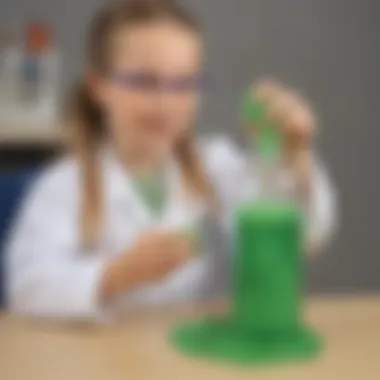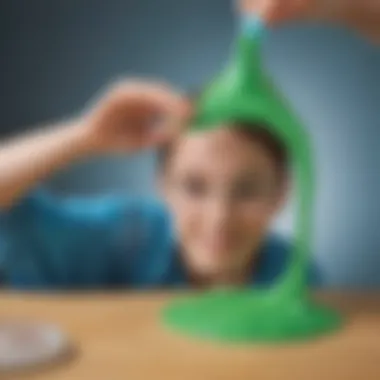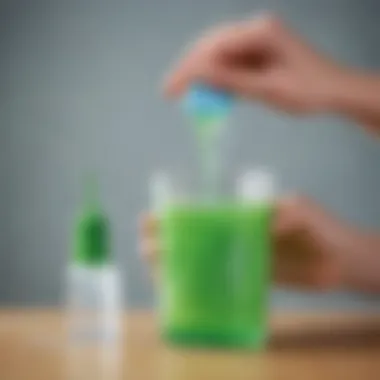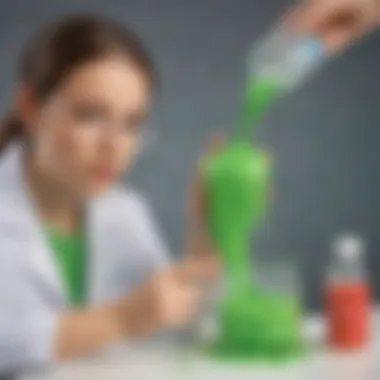Unleashing Creativity: Making Slime with Contact Solution for Young Scientists


Science Fun Facts
Explore the fascinating world of slime-making with contact solution and discover how simple ingredients can create a squishy, gooey substance that kids love to play with. Did you know that slime is a non-Newtonian fluid, meaning its viscosity changes depending on the force applied to it? This property allows slime to act like both a liquid and a solid, offering endless sensory exploration for young scientists.
Discover the Wonders of Science
Delve into the scientific concepts at play while making slime with contact solution. From understanding polymer chains to exploring the principles of viscosity, this experiment introduces children to the basics of chemistry in a hands-on and fun way. Educational videos and animations further enhance learning by visually depicting how ingredients interact to form slime, making science come to life right before their eyes.
Science Experiment Showcase
Engage in a fun and mesmerizing slime-making experiment using contact solution. Follow step-by-step instructions carefully laid out to ensure successful slime creation every time. The materials list includes common household items such as glue, baking soda, and of course, contact solution. Safety tips and precautions are also provided to guarantee a safe and enjoyable scientific exploration for young minds. Get ready to mix, stretch, and play with slime while uncovering the wonders of chemistry in an exciting and interactive way.
Introduction to Slime Making
Slime making is a fascinating activity that has captured the interest and imagination of both children and adults. In this article, we delve into the world of creating slime using contact solution, offering a comprehensive guide for young scientists aged 6-12. By understanding the key components and processes involved in making slime, children can not only engage in a fun and educational experiment but also gain insights into the science behind this popular concoction.
Understanding the Fascination with Slime
Appeal to Sensory Play
The appeal of slime to sensory play lies in its unique tactile properties. Engaging with slime provides children with a hands-on sensory experience, allowing them to explore different textures, consistencies, and sensations. This tactile stimulation enhances sensory development by stimulating various receptors in the hands and fingers, contributing to sensory integration and cognitive processing. The squishy and stretchy nature of slime offers a satisfying sensory experience that can be both calming and enjoyable for children.
Popular amongst Kids
Slime's popularity among kids can be attributed to its versatile nature and entertainment value. Children are drawn to slime-making due to its creative potential and the endless design possibilities it offers. Additionally, the interactive and customizable nature of slime allows kids to experiment with colors, textures, and add-ins, fostering their creativity and imaginative skills. The hands-on nature of slime-making also serves as a break from screen time, encouraging tactile exploration and creativity among children.
Benefits of Slime Making for Children
Enhancing Fine Motor Skills
Slime making contributes to enhancing children's fine motor skills through activities such as mixing, kneading, and stretching the slime. These actions require precise hand movements and coordination, helping children refine their hand-eye coordination and dexterity. As children manipulate the slime, they also strengthen the muscles in their hands and fingers, improving grip strength and control.
Promoting Creativity and Imagination
Engaging in slime-making stimulates children's creativity and imagination by allowing them to create unique concoctions and explore color combinations. Through the process of designing and customizing their slime, children exercise their creative thinking skills and artistic expression. Moreover, experimenting with different textures and effects opens up a world of possibilities, encouraging children to think outside the box and innovate in their slime creations.
Science Behind Slime
Slime-making with contact solution involves a fascinating convergence of chemistry and creativity. Understanding the science behind slime not only adds depth to the experiment but also enriches the experience for young scientists. By delving into the chemistry of slime, children get to explore concepts such as polymerization and the role of cross-linking molecules in creating this gooey substance. Furthermore, grasping the intricate scientific processes at play instills a sense of curiosity and wonder in budding scientists, encouraging them to appreciate the world around them with a critical eye.
Chemistry of Slime
In the realm of slime-making, the chemistry behind this gooey creation is paramount. One of the key aspects is the polymerization process, where molecules combine to form long polymer chains. The polymerization process plays a pivotal role in determining the slime's viscosity and stretchiness. Moreover, by understanding how polymerization works, children can experiment with various materials to achieve different slime textures, fostering a sense of scientific exploration and innovation. On the other hand, cross-linking molecules are essential in enhancing the slime's structural integrity. These molecules act as bridges between polymer chains, adding strength and elasticity to the final product. By manipulating the cross-linking process, young scientists can customize their slime's properties, emphasizing hands-on learning and experimentation.
Polymerization Process


At the heart of slime-making lies the fascinating polymerization process, where small molecules link together to form long chains. This process is crucial in giving slime its unique properties, such as stretchiness and malleability. By observing how various ingredients interact during polymerization, children can witness firsthand the transformation of liquid components into a solid-like material. Experimenting with the polymerization process allows young scientists to fine-tune their slime-making skills, honing their understanding of chemical reactions and molecular structures.
Cross-Linking Molecules
Another essential component of slime chemistry is the presence of cross-linking molecules. These molecules play a crucial role in connecting polymer chains, creating a network that gives slime its distinctive texture and resilience. Understanding the role of cross-linking molecules provides children with insights into how different additives can alter slime consistency and elasticity. By experimenting with varying amounts of cross-linking agents, young scientists can control the slime's firmness and play around with its tactile properties, fostering a deeper appreciation for the intricacies of molecular interactions.
Role of Contact Solution in Slime Making
Contact solution serves as a pivotal ingredient in the slime-making process, facilitating the transformation of basic household items into a sensory delight for young experimenters. Understanding how contact solution interacts with glue and borax sheds light on the chemical reactions that underpin slime creation, turning a seemingly simple experiment into a scientific exploration. Moreover, the ability of contact solution to create a viscous texture in slime adds an element of excitement, allowing children to engage with materials in a hands-on and immersive manner.
Interaction with Glue and Borax
The interaction between contact solution, glue, and borax is a critical juncture in slime-making. Contact solution acts as a binding agent, linking the components together and kickstarting the slime formation process. By observing how contact solution alters the chemical structure of glue and borax, young scientists can uncover the transformative power of seemingly ordinary household products. This hands-on experience not only educates children about chemical reactions but also nurtures their sense of curiosity and experimentation.
Creating Viscous Texture
One of the most thrilling aspects of using contact solution in slime-making is its ability to create a viscous texture that is both playful and engaging. The addition of contact solution transforms the basic ingredients into a stretchy and slime-like substance, inviting children to explore its sensory qualities. By adjusting the amount of contact solution added, young scientists can tailor the slime's texture to suit their preferences, encouraging them to think critically about the impact of different variables on the final outcome. This tactile experience not only provides hours of entertainment but also instills a sense of scientific inquiry and discovery in children, setting the stage for future experiments and explorations.
Materials Needed for Making Slime
In the realm of creating slime with contact solution, the foundation lies in understanding the critical aspects of the materials required for this tactile and educational process. Each component plays a significant role in the overall outcome, ensuring a successful and enjoyable experience for young scientists venturing into the world of slime-making. The careful selection and utilization of these materials can enhance the learning experience while fostering creativity and curiosity in children.
Gathering Supplies
Glue, Contact Solution, Baking Soda
Delving into the essential elements of glue, contact solution, and baking soda unveils their indispensable roles in crafting slime. Glue serves as the primary binding agent, facilitating the cohesion of other ingredients to form a cohesive mixture. Contact solution acts as the key activator, triggering the chemical reaction essential for slime formation. Baking soda, with its alkaline properties, aids in the controlling of texture and consistency, contributing to the final product's sensory appeal.
Furthermore, the unique nature of each component ensures a smooth and interactive slime-making process, where children can witness the captivating transformation as the ingredients blend harmoniously to create a malleable substance. While these elements offer numerous advantages in producing quality slime, it's essential to consider safety measures and appropriate handling techniques to guarantee a safe and enjoyable experience for young participants.
Food Coloring and Glitter (Optional)
Adding a touch of aesthetic appeal to the slime-making endeavor, food coloring and glitter present children with the opportunity to personalize their creations. Food coloring infuses vibrant hues into the slime, allowing young scientists to experiment with different shades and tones, fostering an appreciation for color theory and design concepts. On the other hand, the inclusion of glitter introduces a sparkling element, elevating the visual and tactile experience of the slime, captivating young minds with its shimmering effects.
While optional, these supplementary materials offer a creative outlet for children to explore artistic expression and individuality in their slime designs. Parents and caregivers can encourage young learners to experiment with various color combinations and glitter accents, encouraging imaginative play and sensory exploration. However, prudent consideration of allergies and sensitivities is paramount when incorporating these additives, ensuring a safe and engaging slime-making session for all participants.
Step-by-Step Guide to Making Slime
Creating slime with contact solution is a versatile and engaging activity that combines scientific principles with fun. In this comprehensive guide, we will walk through the various steps involved in making slime, ensuring a smooth and successful slime-making experience every time. From preparation to achieving the perfect consistency, each stage plays a crucial role in the overall outcome of your slime. Following these steps diligently will result in a satisfying slime creation process that guarantees both enjoyment and learning.
Preparation Steps
Setting Up Workstation
Before delving into the slime-making process, it's essential to set up an organized and clutter-free workstation. Having a designated area for mixing and experimenting not only streamlines the process but also ensures safety and efficiency in handling the materials. A clean, flat surface with easy access to water and paper towels is ideal for this task. By establishing a well-structured workstation, you create a conducive environment for a smooth slime-making journey.


Measuring Ingredients
Accurate measurement of ingredients is critical in achieving the desired slime consistency. Be meticulous when measuring the glue, baking soda, and contact solution, as even slight variations can impact the final outcome. Use measuring cups and spoons for precision, following the recipe guidelines closely. Measuring ingredients meticulously is a fundamental step that sets the foundation for a successful slime-making session.
Mixing Process
Combining Glue and Baking Soda
Once your ingredients are accurately measured, it's time to combine the glue and baking soda. Mixing these components thoroughly is key to initiating the polymerization process that forms the slime. The glue provides the base for the slime, while the baking soda acts as a catalyst in creating the desired texture. Stirring the mixture evenly ensures a uniform distribution of ingredients, setting the stage for the next crucial step.
Adding Contact Solution
The addition of contact solution is where the transformation from glue to slime happens. Contact solution acts as the activator that binds the glue molecules together, creating a viscous and stretchy substance. Gradually pour the contact solution into the glue mixture while stirring continuously. The texture of the slime will start to form, signaling that you're on the right track. Carefully monitor the consistency as you add the contact solution, as this step determines the final feel of your slime.
Achieving Desired Consistency
Testing Stretchiness
After incorporating the contact solution, test the stretchiness of the slime. Gently pull the slime apart to assess its elasticity and firmness. The ideal slime should stretch easily without breaking while maintaining its shape when at rest. Adjust the ingredients if needed to achieve the desired stretchiness, ensuring a satisfying sensory experience during playtime.
Adjusting Contact Solution Quantity
If the slime is too sticky or stiff, consider adjusting the contact solution quantity. Gradually add more contact solution if the slime is too sticky, or incorporate a bit more glue if it's too firm. Finding the perfect balance is key to achieving a slime consistency that is both malleable and enjoyable to play with. Experiment with slight adjustments until you reach the desired texture, customizing the slime to your preference.
Variations and Customizations
In the realm of making slime with contact solution, exploring variations and customizations adds an extra layer of excitement and creativity to the process. By delving into different colors, textures, and effects, children can customize their slime-making experience according to their preferences and imagination. Emphasizing the importance of variations and customizations in this article allows young scientists to unleash their creativity and experiment with different elements, enhancing their sensory play and cognitive development. Engaging in variations and customizations not only fosters a sense of innovation but also encourages children to think outside the box, promoting problem-solving skills and imaginative thinking.
Experimenting with Different Colors
Mixing Pigments for Unique Shades
When it comes to mixing pigments for unique shades in slime, it opens a world of color possibilities for young creators. The process involves carefully blending different hues to create customized colors that reflect personal style and creativity. Mixing pigments for unique shades contributes significantly to the overall goal of promoting individuality and self-expression among young scientists. The key characteristic of mixing pigments for unique shades lies in the endless combinations available, allowing children to experiment with color theory and explore their artistic preferences. This aspect is a popular choice for this article as it allows young minds to engage in a hands-on activity that nurtures their artistic talents and encourages them to express themselves through vibrant hues.
Creating Rainbow Slime
Creating rainbow slime offers young scientists a mesmerizing experience filled with color and wonder. This particular aspect contributes to the overall topic by adding a visual delight to the slime-making process. The key characteristic of creating rainbow slime is the vibrant and harmonious display of multiple colors swirling together, creating a captivating visual impact. It is a beneficial choice for this article as it introduces children to the concept of color mixing and provides a sensory-rich experience that stimulates their visual senses. The unique feature of creating rainbow slime is its ability to engage children in a multisensory activity that combines learning with play, fostering a deeper appreciation for color and aesthetics.
Adding Texture and Effects
Incorporating Glitter or Beads
Incorporating glitter or beads into slime introduces an element of texture and sparkle, elevating the sensory experience for young scientists. The key characteristic of this aspect is the sensory feedback it provides, enhancing tactile exploration and sensory play. Incorporating glitter or beads is a popular choice for this article as it encourages children to engage multiple senses simultaneously, promoting cognitive development and sensory integration. The unique feature of incorporating glitter or beads is the added visual and tactile appeal it brings to slime, creating a multisensory experience that captivates young learners and stimulates their creativity.
Using Scented Oils


Using scented oils in slime-making empowers young scientists to explore olfactory sensations and engage their sense of smell during playtime. The key characteristic of using scented oils is the aromatic experience it offers, introducing children to the world of aromatherapy in a playful context. This aspect is a beneficial choice for this article as it combines sensory exploration with the science of scents, allowing children to create personalized slime with signature fragrances. The unique feature of using scented oils is its potential to evoke emotions and memories through scent, enriching the sensory play experience and adding a new dimension to the creative process.
Storing and Playing with Slime
When it comes to the world of slime-making, proper storage and engaging play are crucial elements to ensure a lasting and enjoyable experience for young scientists. Storing and playing with slime not only extends the life of this fun creation but also enhances the sensory experience and promotes creativity.
Proper Storage Tips
Sealing in Airtight Containers
Sealing slime in airtight containers stands out as a key practice in maintaining its freshness and preventing it from drying out. The impermeable nature of airtight containers ensures that the slime retains its desired texture and viscosity for an extended period. This feature makes airtight containers a popular choice for storing slime, as it effectively seals in the moisture, keeping the slime ready for future play sessions. Additionally, the secure seal of airtight containers minimizes the risk of spills or leaks, making them a practical and safe storage option for slime enthusiasts. Overall, the ability of airtight containers to preserve the quality of slime makes them an indispensable asset for any slime-making activity.
Avoiding Exposure to Heat
Shielding slime from exposure to heat is another essential aspect of proper storage. Heat can alter the consistency and properties of slime, potentially leading to hardening or melting, which can diminish the overall enjoyment of playing with it. By keeping slime away from heat sources such as direct sunlight or heaters, enthusiasts can maintain its desired texture and stretchiness. Avoiding heat exposure also helps prolong the lifespan of slime, ensuring that it remains pliable and engaging for numerous play sessions. Therefore, a vigilant approach to storing slime away from heat sources preserves its integrity and guarantees a superior sensory play experience.
Enjoying Sensory Play
Embarking on the sensory journey of playing with slime offers young scientists a stimulating and immersive experience that nurtures their imaginative prowess and fine motor skills.
Stretching and Squishing
The tactile sensation of stretching and squishing slime captivates young minds, providing a therapeutic outlet for stress relief and sensory exploration. The elasticity of slime allows children to engage in mesmerizing stretch-and-squish movements, promoting hand-eye coordination and tactile sensitivity. This interaction with slime stimulates sensory receptors, offering a calming and enjoyable playtime activity that enhances focus and dexterity. The unique malleability of slime makes it an ideal medium for enhancing sensory play benefits while encouraging creative expression and motor skill development.
Creating Shapes and Figures
Exploring the art of shaping and molding slime into various forms unleashes a realm of possibilities for creative expression and imaginative play. Children can mold slime into different shapes, animals, or objects, encouraging spatial awareness and artistic exploration. The pliable nature of slime allows for easy manipulation, empowering young scientists to sculpt intricate designs and experiment with textures. By engaging in shape and figure creation, children exercise their cognitive abilities, fostering problem-solving skills and spatial reasoning. This hands-on approach to slime play not only sparks creativity but also promotes manual dexterity and visual-spatial intelligence, making it a versatile and enriching sensory play experience.
Safety Precautions and Cleanup
In the realm of conducting scientific experiments, safety precautions and cleanup play a pivotal role. When conducting any experiment, especially one involving chemicals like making slime with contact solution, ensuring the safety of the individuals involved is paramount. This section delves into the critical aspects of maintaining a safe environment and the necessary clean-up procedures post-experimentation. Attention to detail is key to fostering a secure and enriching learning experience for young scientists.
Handling Chemicals Safely
Supervising Children
When it comes to supervising children during scientific activities, vigilance is crucial. Monitoring their interactions with materials like glue, contact solution, and other substances is essential to prevent accidents or mishandling. By supervising children closely, caregivers can guide them through the experiment, emphasizing the importance of following instructions and safety guidelines. This hands-on supervision not only ensures a safe environment but also instills a sense of responsibility and respect for safety measures in young scientists.
Washing Hands After Use
After engaging in any experiment involving chemicals, such as making slime, proper hand hygiene is non-negotiable. Washing hands thoroughly with soap and water helps in removing any residue from the materials used, preventing skin irritation or accidental ingestion. Encouraging children to wash their hands after the experiment promotes good hygiene practices and reinforces the importance of cleanliness. By incorporating this simple yet critical step, caregivers can instill healthy habits in children, creating a safe and hygienic environment for scientific exploration.
Cleaning Up Spills
When spills occur during experimentations like slime making, prompt and efficient cleanup is imperative. Addressing spills promptly helps prevent slip hazards and ensures a tidy workspace for future activities. This section focuses on two key aspects of spill management: using warm soapy water and avoiding drain disposal.
Using Warm Soapy Water
Utilizing warm soapy water for cleaning spills is an effective method to remove any sticky residues left behind by the materials. The combination of warm water and soap helps break down the components of the spill, making it easier to wipe clean surfaces. This gentle yet efficient approach not only ensures thorough cleaning but also promotes a safe environment free from slippery residues.
Avoiding Drain Disposal
Disposing of spill remnants down the drain can have adverse effects on the plumbing system and the environment. Avoiding drain disposal by wiping up spills with paper towels or cloths prevents clogs and contamination. By disposing of spill residues in designated trash bins, individuals contribute to environmental conservation and maintain the integrity of plumbing systems. This conscious approach to cleanup safeguards both indoor and outdoor environments, aligning with sustainable practices and promoting responsible waste management.







